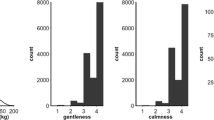Abstract
Guard honeybees stand at the entrance of colonies and facilitate the exclusion of nonnestmates from the colony. In this study, we examined the hypothesis that genetic variability among individuals in colonies might explain variability in guarding activity. To do this, we cross-fostered honey bees between colonies with high-defensive responses and colonies with low-defensive responses in alarm pheromone tests. Individuals from high-defensive colonies were more likely to guard in their own colonies (controls) than cross-fostered bees from low-defensive colonies. Cross-fostered high-defensive bees also were more likely to guard in low-defense colonies. These results support the hypothesis that interindividual differences in guarding behavior are at least partially under genetic control. A positive correlation between number of guards and response to alarm pheromone demonstrates a link between behaviorally separated components of the overall defensive response.
Similar content being viewed by others
References
Brandes, Ch. (1988). Estimation of heritability of learning behavior in honeybees (Apis mellifera capensis).Behav. Genet. 18:119–132.
Breed, M. D. (1983). Nestmate recognition in honeybees.Anim. Behav. 31:86–91.
Breed, M. D., Robinson, G. E., and Page, R. E. (1990). Division of labor during honey bee colony defense.Behav Ecol. Sociobiol. 27:395–401.
Breed, M. D., Rogers, K. B., Hunley, J. A., and Moore, A. J. (1989). A correlation between guard behaviour and defensive response in the honeybee,Apis mellifera. Anim. Behav. 37:515–516.
Calderone, N., and Page, R. E. (1991). A genotype x colony-environment interaction effect on pollen-hoarding behavior of worker honeybees (Apis mellifera) (manuscript in preparation).
Collins, A. M. (1979). Genetics of the response of the honeybee to an alarm pheromone, isopentyl acetate.J. Apic. Res. 18:285–291.
Collins, A. M., and Kubasek, K. J. (1982). Field test of honeybee colony defensive behavior.Ann. Entomol. Soc. Am. 75:383–387.
Collins, A. M., Rinderer, T. E., Tucker, K. W., Sylvester, H. A., and Lackett, J. J (1980). A model of honeybee defensive behavior.J. Apic. Res. 19:224–231.
Collins, A. M., Rinderer, T. E., Harbo, J. R., and Brown, M. A. (1984). Heritabilities and correlations for several characters in the honeybee.J. Hered. 75:135–140.
Frumhoff, P. C., and Baker, J. (1988). A genetic component to division of labour with honeybee hives.Nature 333:358–361.
Maschwitz, U. (1964). Gefahrenalarmstoffe und Gefahrenalrmierung bei sozialen Hymenopteren.Z. Vergl. Physiol. 47:596–655.
Moore, A. J., Breed, M. D., and Moor, M. J. (1987). Characterization of guard behavior in honeybees,Apis mellifera.Anim. Behav. 35:1159–1167.
Moritz, R. F. A. (1986). Estimating the genetic variance of group characters: Social behaviour of honeybees (Apis mellifera L.).Theor Appl. Genet. 72:513–517.
Moritz, R. F. A., and Klepsch, A. (1985). Estimation of heritabilities of worker characters: A new approach using laying workers of the cape honeybee (Apis mellifera capensis Esch.).Apidologie 16:47–56.
Moritz, R. F. A., and Southwick, E. E. (1987). Phenotype interactions in group behavior of honeybee workers (Apis mellifera L.).Behav. Ecol. Sociobiol. 21:53–57.
Moritz, R. F. A., Southwick, E. E., and Harbo, J. R. (1987). Maternal and pre eclosional factors affecting alarm behaviour in adult honeybees (Apis mellifera L.).Insectes Soc. 34:298–307.
Robinson, G. E., and Page, R. E. (1988). Genetic determination of guarding and undertaking in honeybee colonies.Nature 333:356–358.
Robinson, G. E., and Page, R. E. (1989). Genetic determination of nectar foraging, pollen foraging, and nest-site scouting in honeybee colonies.Behav. Ecol. Sociobiol. 24:317–323.
Robinson, G. E., Page, R. E., Strambi, C., and Strambi, A. (1989). Hormonal and genetic control of behavioral integration in honeybee colonies.Science 246:109–112.
Seeley, T. D., Seeley, R. H., and Akratanakul, P. (1982). Colony defense strategies of the honeybees in Thailand.Ecol. Monogr. 52:43–63.
Winston, M. L. (1987).The Biology of the Honeybee, Harward University Press, Cambridge, Mass.
Author information
Authors and Affiliations
Additional information
This work was supported by NSF Grant BNS 8605604.
Rights and permissions
About this article
Cite this article
Breed, M.D., Rogers, K.B. The behavioral genetics of colony defense in honeybees: Genetic variability for guarding behavior. Behav Genet 21, 295–303 (1991). https://doi.org/10.1007/BF01065821
Received:
Accepted:
Issue Date:
DOI: https://doi.org/10.1007/BF01065821




